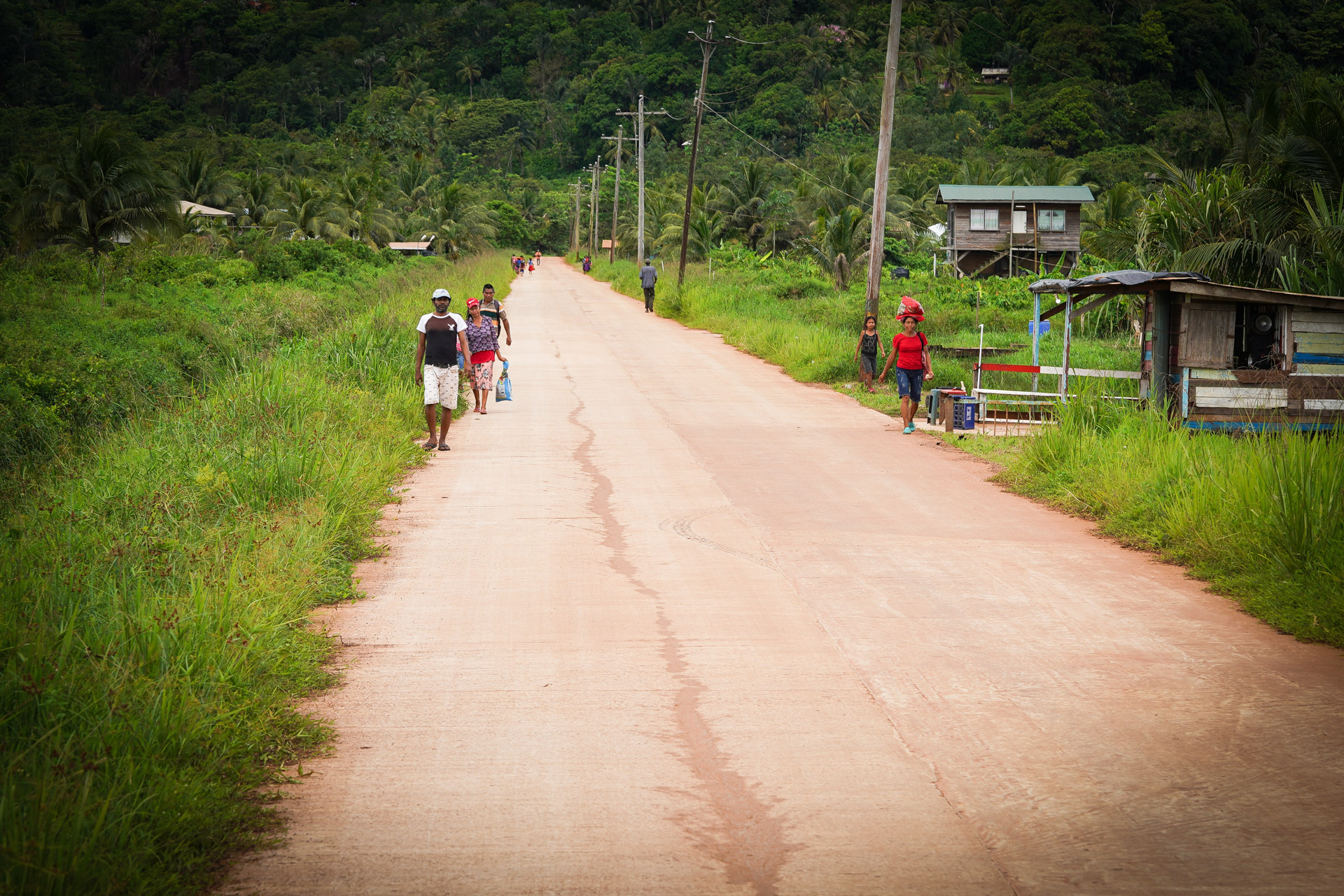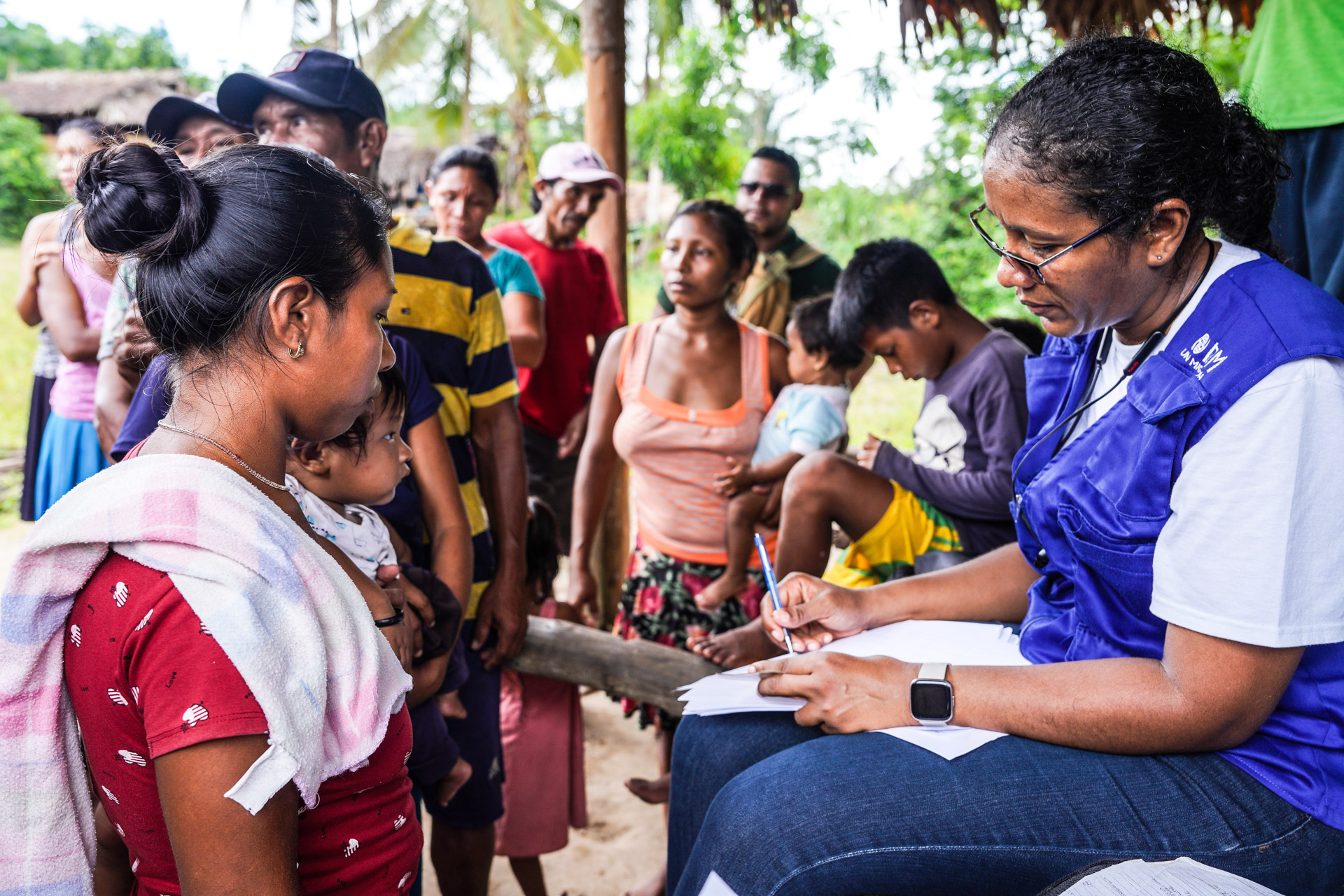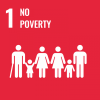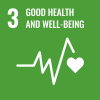Anabisi, 31 July 2023 – In an indigenous community in Guyana’s Amazon Forest, women wait in the sweltering heat for aid distributions to start. Maria* sits quietly with her grandchildren looking at the boats unloading cargo. “I feel fortunate that aid came to my community,” says the 56-year-old woman who had to leave her home in Venezuela with her 14-member extended family. “In addition to food, we will receive agricultural tools that will allow us to plant our own vegetable gardens to survive.”
Fish and taro were the only food Maria and her family could find in their little community in the Orinoco River Delta, home of the Warao, the second-largest indigenous group in Venezuela. She recalls that in 2019 her four-day boat journey to Guyana with her family was not easy. “It was very unpleasant; my sons had to paddle nonstop, we took many risks, including having to sleep together on the three boats, at night, during the rain,” Maria says, looking at her grandchildren. “We did it for them so that they can have a better life.”

Life-saving assistance including food, hygiene kits, mosquito nets, hammocks and agricultural tools being distributed in Anabisi, a small indigenous community in the north of Guyana. Photo: IOM/Gema Cortes

Anabisi is a small, isolated indigenous community bordering Venezuela, in the far north of Guyana. Photo: IOM/Gema Cortes

IOM staff during aid distribution to indigenous communities in Guyana’s Amazon rainforest. Photo: IOM/Gema Cortes

A Venezuelan Warao indigenous person paddling away with humanitarian supplies received. Photo: IOM/Gema Cortes
Maria and her family now live in Anabisi, a small community bordering Venezuela, in the far north of Guyana. There, around 20 Venezuelan Warao families live in thatched roof huts with no walls called Palafitos. The huts are built on stilts due to the river’s water levels rising between one to two meters daily.
With medicine and food scarce at home, Venezuelan Waraos left their lands in search of better opportunities in Guyana. Most traveled long distances on foot or used boats to cross the border, looking for a better quality of life in communities of Guyanese Warao, who have welcomed them. They arrived with pressing needs for food, shelter, and health care, vulnerable to exploitation, abuse, violence, and discrimination.

The Warao indigenous people are known as “the boat people” after their connection to water. Photo: IOM/Gema Cortes

Warao indigenous people are the second indigenous group in Venezuela. Photo: IOM/Gema Cortes

Aerial view of road on Amazon Forest in northern Guyana. Photo: IOM/Gema Cortes

Boat arriving with humanitarian aid for the indigenous community. Photo: IOM/Gema Cortes
The International Organization for Migration (IOM) is on the front line providing these migrants and their host communities on the banks of the hard-to-reach Kaituma river with much-needed assistance. This is part of an effort to support the Government of Guyana, which coordinated storage and transportation of items to the communities, including food, hygiene kits, buckets, mosquito nets, hammocks, blankets, and other supplies such as shovels, axes, and machetes, among the assistance provided.
Against the odds
Geographic remoteness, harsh weather, and impassible rivers are but a few of the challenges IOM staff grapple with as they deliver humanitarian aid to hard-to-reach areas in northern Guyana. Extremely limited geographic access has an impact on the population.

Venezuelan migrant carrying relief supplies under the rain. Photo: IOM/Gema Cortes

Warao boy near relief aid at indigenous community. Photo: IOM/Gema Cortes

Road to Mabaruma, a small town bordering Venezuela in northern Guyana. Photo: IOM/Gema Cortes

Mabaruma, a small town in the Amazon Forest. Photo: IOM/Gema Cortes
“Access is a major issue,” says Mineta Mcklmon, IOM’s Senior Project Assistant. “We are using small planes, boats, tractors and human power to haul supplies where other means could not go. There are hardly any roads; during the rainy season everything is flooded, and it is very challenging to provide aid.”
Getting to Anabisi is not an easy task. It is only accessible by small plane and boats. Its remoteness and the surrounding environment of the Amazon jungle contribute to keeping the village isolated. Life-saving assistance is flown in on small planes before being trucked to some communities and transported by boat to others.

Small plane being loaded with humantarian assistance. Photo: IOM/Gema Cortes

Indigenous community waiting for relief distribution. Photo: IOM/Gema Cortes

Delivering aid from a truck in northern Amazon rainforest. Photo: IOM/Gema Cortes

Indigenous Warao boy on hammock. Photo: IOM/Gema Cortes
Fishing tools and two boats intended for both migrants and locals were also provided, including one fishing boat and one passenger boat that will help transport people to health centres and address other community needs.
The provision of valuable information, including guides on how to access documentation and the regularization process is also a regular activity. “People are pretty thankful for the activities and the fact that we are coming to the river-based communities to assist them,” says Aura Vasquez, IOM Project Assistant.
Love prevails over adversity
More than 7.2 million Venezuelans have left their country in recent years, and Guyana is host to almost 20,000 who left widespread food and medicine shortages back home. This includes indigenous Warao individuals and families, who face particularly steep hurdles meeting their basic needs and adjusting to a new life.

Close up of distribution lists. Photo: IOM/Gema Cortes

Mineta Mcklmon, IOM’s Senior Project Assistant. Photo: IOM/Gema Cortes

Indigenous Warao woman carrying cassava. Photo: IOM/Gema Cortes

Marianis, 21, found hope in Guyana through love. Photo: IOM/Gema Cortes
In the English-speaking country, they often grapple with a double language barrier, as many, particularly elderly people, only speak the Warao language and struggle with Spanish.
Despite challenging hardships and a treacherous 300-kilometer southward journey to Guyana, Marianis*, 21, had her dream of a new life restored in Guyana; she found hope through love. She arrived in 2020 with her parents and two brothers and met her now husband there.
She is now happily married to Jose*, a young Guyanese man and is looking forward to starting a new family. “Since the moment we met we have been together, and we are pushing forward together. We’re going to build a new life together wherever that may be,” Marianis said, reminiscing about the pleasant yet unexpected turn her life in Guyana took.

Guyana is host to 20,000 Venezuelan migrants. Photo: IOM/Gema Cortes

Torrential rain in Amazon rainforest. Photo: IOM/Gema Cortes

Aid being distributed in northern Guyana. Photo: IOM/Gema Cortes

Warao indigenous people face hurdles meeting basic needs in Guyana. Photo: IOM/Gema Cortes
*Names have been changed for protection reasons.
This story was written by Gema Cortes, IOM Media and Communications Unit, Office of the Special Envoy for the Regional Response to the Venezuela Situation.




